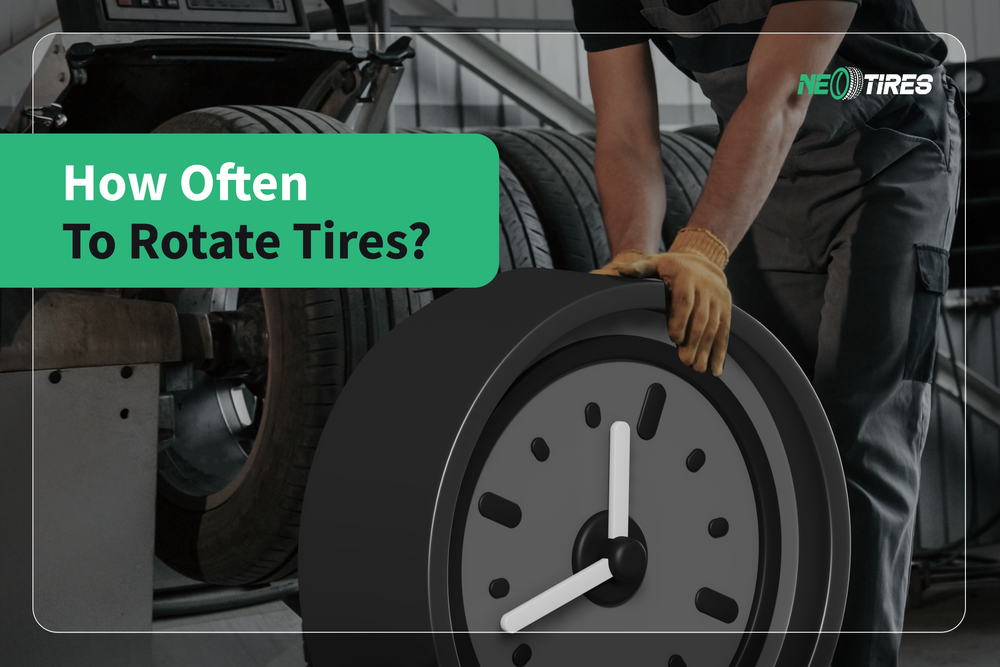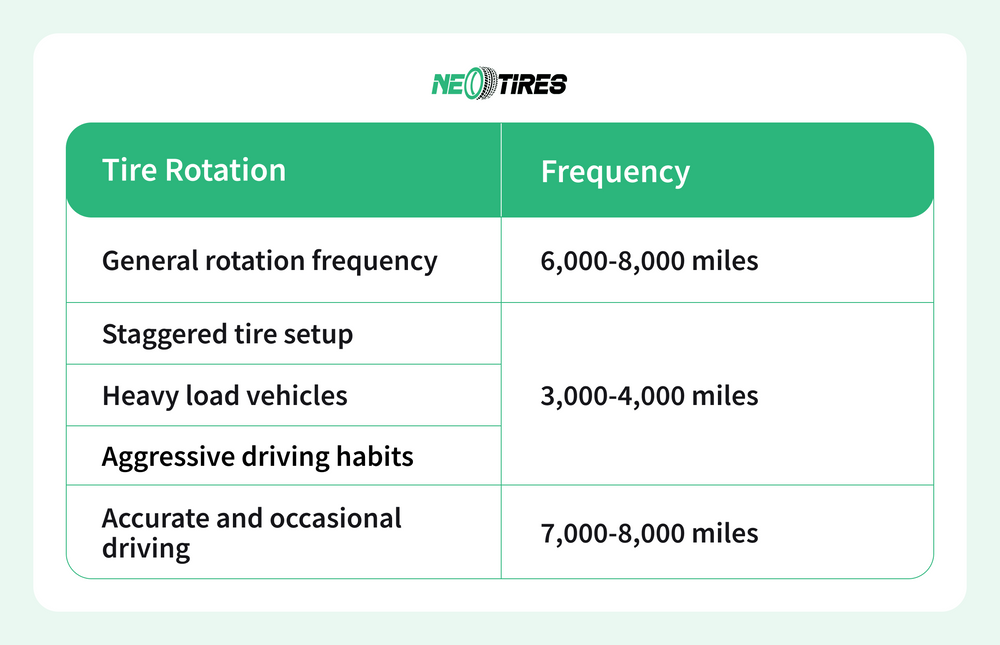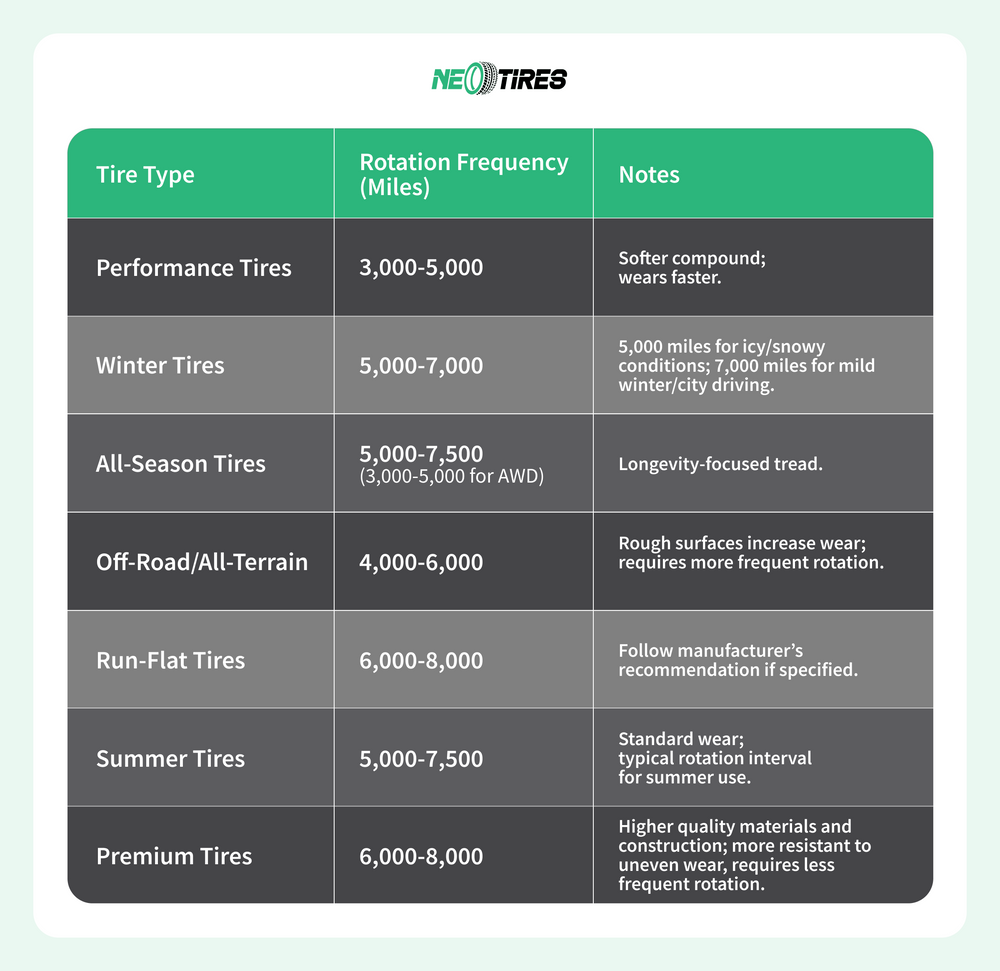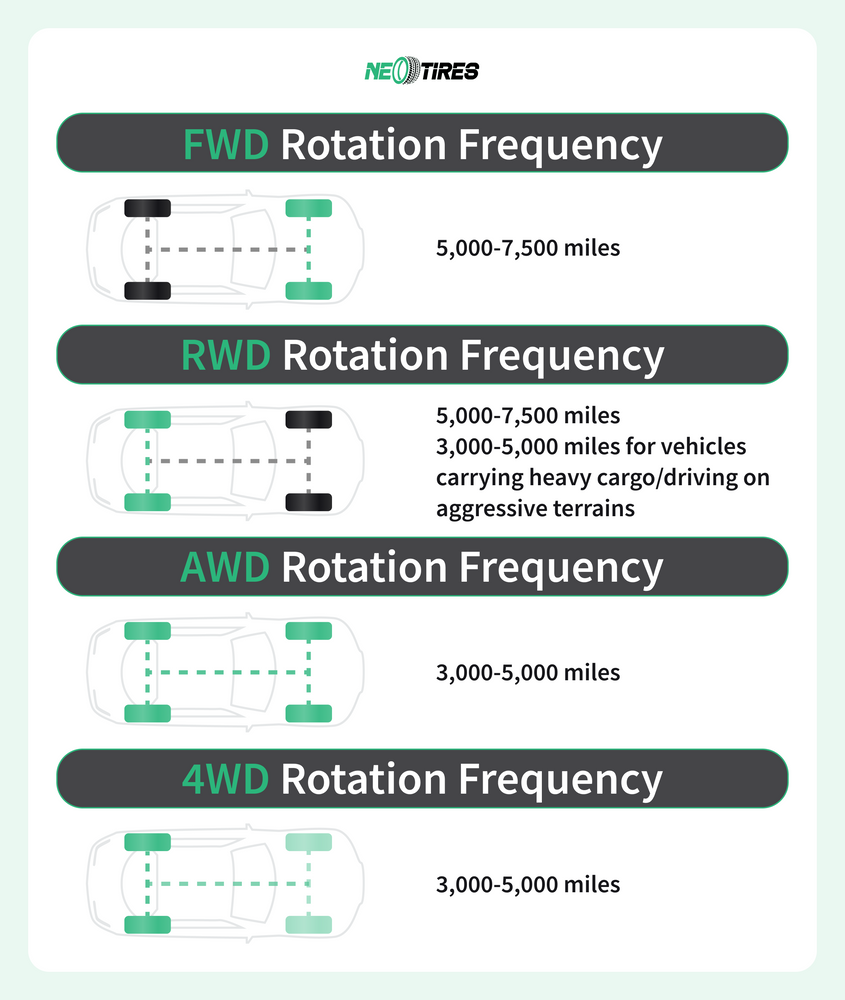Tire rotation is the process of changing the position of the vehicle's tires at regular time intervals of 6,000-8,000 miles (9,656-12,875 km) or every 6 months. Regular tire rotation helps maximize tire life and ensure even tread wear.
The rotation frequency varies depending on the type of vehicle (FWD/RWD/AWD/4WD), the type of tires, driving habits, and conditions. The recommended rotation time for AWD vehicles is every 3,000-5,000 miles (as per NHTSA) and 5,000 to 7,500 miles for FWD and RWD vehicles.
Rotating tires earlier (every 3,000-4,000 miles) are recommended for staggered tire setup, heavy-load vehicles, and aggressive driving habits. Drivers can delay tire rotation (7,000-8,000 miles) when the tread wear is even across all tires and when driving smoothly.
How Often Should You Rotate Tires?
The recommended tire rotation is between 6,000 and 8,000 miles or every 6 months, whichever comes first (as per Michelin). However, for AWD, commercial, staggered, and performance vehicles, rotate tires sooner (3,000 to 5,000 miles). Always check the driver's manual for the individual manufacturer’s recommendations.
While the general recommendation is between 6,000 and 8,000 miles, the tire rotation frequency can vary between US regions, considering the different climates. For example, Northeast US (Philadelphia, New York) drivers are recommended to rotate every 5,000-7,000 miles. It's because of the harsh cold season and road salt speeding up the tire wear process.
Southwest US drivers (Miami, Atlanta) can delay tire rotation between 6,000-8,000 miles, as the mild winters and hot, humid summers are more gentle to tire wear. Due to mountainous terrains and varying temperatures, drivers in Denver and similar Mountain West regions should consider tire rotation every 4,000-6,000 miles.
It's a good practice to rotate tires as often as changing car oil (every 5,000-7,500 miles), saving time and keeping your vehicle running smoothly.
FWD Tire Rotation Frequency
The NHTSA recommends rotating the tires of FWD vehicles at intervals between 5,000 and 7,500 miles. This allows for equalizing treadwear and maximizing tire life.
This interval is optimal for evening the stress on the front tires, which typically wear faster on FWD vehicles. Ignoring rotation at 5,000-7,500 miles on an FWD amplifies the increased load and torque on the front wheels, speeding up the uneven wear process.
RWD Tire Rotation Frequency
Rotate the tires of RWD vehicles every 5,000-7,500 miles, as this interval is optimal for reducing stress on the rear tires and ensuring even wear.
RWD rotation might be necessary earlier, at every 3,000-5,000 miles, with towing trailers and vehicles carrying heavy cargo, when driving on aggressive terrain, or when observing rapid, uneven wear. Always inspect your tire condition and follow the manufacturer’s recommendation for specific rotation rules.
AWD Tire Rotation Frequency
Tires on AWD vehicles should undergo tire rotation every 3,000-5,000 miles to protect the AWD system and prolong tire life.
AWDs typically need earlier rotation than FWDs and RWDs as they send power to all 4 wheels simultaneously, speeding up the tire wear rate.
4WD Tire Rotation Frequency
The recommended tire rotation frequency for 4WD vehicles is between 3,000-5,000 miles. Rotating at 3,000-5,000 miles is optimal to even the stress on the four wheels, as all wheels simultaneously engage in propulsion and traction.
Earlier rotation in 4WD compared to FWD and RWD is due to the high torque demand, which brings about earlier tire wear. 4WDs are typically built for rugged terrain, off-roading, and heavy-duty tasks, which can cause faster and/or uneven wear.
How Often To Rotate Tires For Heavier Vehicles?
Rotate heavier vehicles between 5,000-7,000 miles. Dually truck tire rotation interval is typically every 5,000-7,000 miles, whereas heavy load trucks and SUVs- every 5,000-6,000 miles. Off-road and rugged terrain vehicles need earlier rotation every 4,000-6,000 miles, due to rough surfaces, which speed up tire tread wear.
Does The Tire Type Influence Tire Rotation Frequency?
Yes, the tire type can impact the tire rotation frequency. Performance tires are generally rotated every 3,000-5,000 miles as their compound is softer and wears out faster. Learn more about UHP Tires Explained.
Depending on your specific winter conditions, you can rotate winter tires every 5,000-7,000 miles. For example, Rotate winter tires every 5,000 miles in conditions of consistently icy roads and/or frequent snowstorms and every 7,000 miles with city driving in mild winter conditions.
All-season tires are generally rotated every 5,000-7,500 miles, as their tread compound aims for longevity and doesn’t wear as fast as performance tires. AWD vehicles require more frequent rotation (3,000-5,000 miles).
Considering the rough surfaces they typically roll on, off-road and all-terrain tires are typically rotated every 4,000-6,000 miles. Unless the manufacturer recommends otherwise, run-flat tires need rotation every 6,000-8,000 miles.
Standard summer tires are typically rotated within 5,000-7,500 miles. Premium tires usually require less frequent rotation, every 6,000-8,000 miles, due to their advanced construction and higher-quality materials, which makes them more resistant to uneven wear.
Do Driving Conditions Affect Tire Rotation Frequency?
Yes, driving conditions have a significant impact on the tire rotation frequency. Consider rotating tires every 3,000-5,000 miles in off-road driving conditions, as the rough terrain subjects tires to uneven wear.
City driving conditions require tire rotation between 3,000-6,000 miles due to frequent starts and stops (about 3,000 miles for AWD and 6,000 miles for FWD/RWD vehicles).
Rotation can be performed every 7,000-8,000 miles if driving primarily on highways. Fewer stops and consistent speed in highway driving allow longer intervals between rotations than city or off-road driving.
Aggressive driving (hard braking, fast cornering, rapid acceleration) requires more frequent rotation every 3,000-5,000 miles. Rotate tires every 5,000-7,500 miles in mixed conditions when you frequently switch from highway/urban to off-road driving conditions.
Does Climate And Seasonal Changes Affect Tire Rotation Frequency?
Yes, climate changes and seasonal shifts can influence tire rotation frequency. In cold and snowy temperatures, winter tires should be rotated every 5,000-7,000 miles to reduce the impact of ice exposure, salt and chemical treatments, and extreme cold on tread contact.
Extreme heat and the hot pavement increase tire wear rate and soften rubber compounds. Rotate tires earlier, every 4,000-6,000 miles, to mitigate the impact of hot temperature on tire wear.
Drivers living in mixed seasonal conditions (cold winters and hot summers) should rotate tires between 5,000-7,500 miles. Drivers should switch to seasonal tires once the temperatures change to prepare the vehicle for the upcoming seasonal temperatures. Perform tire change AND rotation from summer to all-season or winter tires (or vice versa) with increasing or decreasing temperatures, even if you didn’t reach the recommended 5,000-7,500-mile rotation interval.
How Can Driving Habits Affect Tire Rotation Frequency?
Driving habits affect tire rotation frequency as the driving style can prolong or reduce the lifespan. Aggressive driving, like frequent braking, sharp cornering, high-speed driving, and hard acceleration, requires rotation at 3,000-5,000 miles. That is what ASE (National Institute for Automotive Service Excellence) recommends, even if driving in urban areas.
More frequent tire rotation (every 3,000-5,000 miles) is necessary for vehicles carrying tow or heavy loads, especially for tires not meant for heavy-duty tasks. Drivers who frequently overload their vehicles (which is not recommended) should consider early tire rotation to distribute the stress.
How Can Tire Rotation Frequency Affect The Tire Warranty?
Timely rotation is mandatory for many manufacturers, such as Michelin, Bridgestone, Continental, Pirelli, Toyo, or Cooper, to keep the warranty valid. Michelin, for example, recommends tire rotation within 6,000-8,000 miles or at least once a year. Depending on the tire type and model, this can range between 45,000-80,000 miles.
Goodyear recommends rotating tires every 3,000-6,000 miles. Failure to do so can void the warranty, even for models with a treadwear warranty of up to 65,000 miles, like the Assurance All-Season.
Bridgestone encourages tire rotation every 3,000-5,000 miles to maintain warranty eligibility, while Continental advises performing tire rotation every 6,000-8,000 miles to keep the warranty valid.
NeoTires encourages you always to check the manufacturer's recommendations for each tire type and vehicle. Some tire models, like the Continental TrueContact, have a 90,000-mile warranty. Even so, regular rotation at 6,000 miles is mandatory for the warranty to remain valid. Keep track of all your tire rotation procedures.
What Are The Benefits Of Regularly Rotating Your Tires?
The main benefits of regular tire rotation include:
- tire service life extension for up to 20% through even wear promotion
- contribution to safer handling, steadier traction, better hydroplaning control
- optimization of noise, rolling resistance, and vibrations
- protection of warranty.
Extend Tire Life with the Right Choice!
Timely tire rotation maximizes tread life and ensures better driving performance. Yet, starting with high-quality tires is just as important. If your tires are already showing first signs of wear, it might be time for a replacement.
Visit NeoTires to explore our wide tire selection. We offer long-lasting, durable, and fuel-efficient products to keep you safe and comfortable on the road. Don't hesitate to contact us if you need guidance. We are here to help you make informed decisions professionally. Drive safe and choose your tires wisely!








